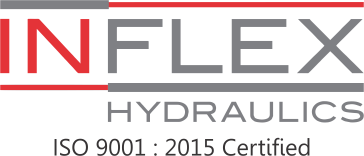High-pressure systems demand durable, reliable, and precisely matched components—especially when dealing with oil transfer applications. Whether you’re working in offshore drilling, hydraulic machinery, or industrial plants, choosing the right oil hose fittings can make or break your operation. The wrong fittings can lead to leakage, pressure loss, or even equipment failure.
At Inflex Hydraulics, we understand the importance of compatibility, pressure tolerance, and material quality when it comes to hose oil systems. This guide will walk you through the crucial factors to consider when selecting oil hose fittings for high-pressure uses.
1. Understand the Application Environment
Before selecting any fitting, you must understand the environment in which it will be used. Consider factors like:
- Operating pressure: High-pressure systems (2000+ PSI) require fittings with robust sealing capabilities.
- Temperature: Extreme temperatures can degrade certain materials quickly.
- Fluid type: Will you be using petroleum-based oils, synthetic oils, or a mixture?
- Movement or vibration: Frequent movement calls for flexible yet secure oil hose fittings.
For example, fuel oil hose fittings used near engines or heat sources must be resistant to heat and vibration fatigue.
Read more: Signs You Need Immediate Hydraulic Hose Repair to Prevent System Failure
2. Material Matters: Choose the Right Composition
Fittings for oil hoses come in various materials, and your choice should depend on both the oil type and environmental exposure.
- Carbon Steel: Affordable and strong, suitable for most petroleum oils.
- Stainless Steel: Excellent for corrosive environments or outdoor use.
- Brass: Often used in moderate-pressure applications but not always ideal for high-pressure systems.
At Inflex Hydraulics, we supply fittings in stainless steel, carbon steel, and other materials that meet ISO and SAE standards for high-pressure operations.
3. Match the Fitting Type to the Hose Design
Not all hoses and fittings are interchangeable. The oil transfer hose you select must work seamlessly with the fitting in both pressure retention and sealing.
Here are some common types of oil hose fittings:
- Crimped fittings: Ideal for permanent installations; offer tight, leak-free seals.
- Reusable fittings: Best for field repairs or maintenance in remote locations.
- Push-on fittings: Convenient for low-pressure or temporary setups.
Each type must be correctly paired with the hose oil structure—braided, spiral-wound, or thermoplastic—to prevent premature failure or leaks.
4. Consider Pressure Rating and Burst Strength
It’s essential that both the fuel oil hose and its fittings can handle the same operating pressure. Mismatched components can result in reduced system performance or dangerous blowouts.
- Always check the Maximum Operating Pressure (MOP) and burst pressure rating.
- Fittings should meet or exceed the pressure rating of the connected oil hoses.
- Avoid fittings that just barely meet the pressure spec—always leave a safety margin.
Pro tip: At Inflex Hydraulics, we help clients evaluate system requirements to ensure the oil hose fittings used are pressure-appropriate and certified for safety.
5. Ensure Compatibility with Oil Type
Not all fittings are compatible with all oils. The oil transfer hose and fittings must be chemically resistant to the fluids in use.
- Petroleum-based oils are typically compatible with nitrile rubber and carbon steel.
- Synthetic or bio-based oils may require special seals like Viton® or fluoropolymer-lined hose oil systems.
Always refer to the material compatibility chart provided by the manufacturer—or better yet, consult the experts at Inflex Hydraulics for personalized guidance.
6. Check for Certification and Compliance
Safety regulations vary across industries and countries. Always verify that your oil hose fittings and hoses meet industry standards such as:
- SAE J517
- ISO 1436
- API certifications (especially for fuel oil and offshore applications)
All Inflex Hydraulics components are manufactured in compliance with international standards to ensure performance, safety, and regulatory approval.
Recommended Reading: 8 Maintenance Tips for Preventing Leaks and Failures in Flexible Pipe Bellows
7. Factor in Installation and Maintenance Ease
Fittings should not just perform under pressure—they should also be easy to install and maintain. Complex configurations or hard-to-reach installations may benefit from swivel or quick-connect fittings.
Here’s why installation matters:
- Easier installs reduce labor time and cost.
- Maintenance access can extend the service life of your oil hoses.
- Reusable fittings may offer cost savings in field replacements.
Inflex offers a wide variety of fitting solutions to support different installation needs, especially in confined or complex hydraulic setups.
Conclusion
Choosing the right oil hose fittings is about more than just size and shape—it’s about compatibility, safety, material integrity, and performance under pressure. Whether you’re managing a high-pressure hydraulic system or transporting fluids through a fuel oil hose, the right fittings will ensure efficiency, reliability, and peace of mind.
At Inflex Hydraulics, we provide tailored solutions for every industrial fluid transfer challenge. From flexible oil hoses to specialized fittings for hose oil systems, our team ensures your operations are supported with world-class products and technical expertise.
Need Help Choosing the Right Fitting?
Contact Inflex Hydraulics today and let our experts guide you to the perfect oil hose fittings for your application.



